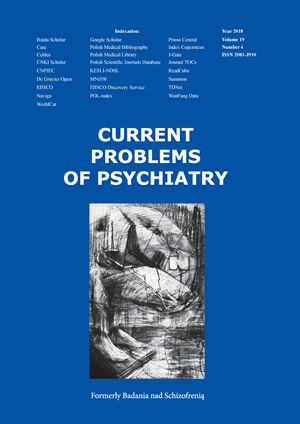Deep brain stimulation in the obsessive-compulsive syndrome
DOI:
https://doi.org/10.2478/cpp-2018-0022Keywords:
deep brain stimulation (DBS), obsessive-compulsive disorder (OCD), nucleus accumbens (NAcc), ventral capsule (VC), ventral striatum (VS)Abstract
Introduction. The authors present an overview of current views on the treatment of obsessive-compulsive disorder refractory to pharmacological and psychological treatment.
Aim: To review the mechanisms of stimulation of deep brain structures and to evaluate the effectiveness of therapy in obsessivecompulsive disorder.
Method: Review and analysis of the Polish and foreign scientific articles from the years 1999-2016.
Conclusions: According to the literature considered, in half of the examined patients there was an improvement of over 35% on the Y-BOCS scale, in some patients even a reduction of symptoms reaching 81-83% was described. Previous studies have been carried out on small groups of patients. Since 2009, the method of invasive treatment with deep brain stimulation of the obsessive-compulsive syndrome is registered in the EU. In spite of the above, additional studies are necessary on a larger group of patients in order to precisely estimate the effectiveness of the procedure and elaborate the criteria for qualifying patients for inclusion in the procedure.
References
1. Antosik-Wójcińska A, Święcicki Ł, Bieńkowski P, Mandat T, Sołtan E. Objawy zespołu Otella po wszczepieniu stymulatora jądra niskowzgórzowego – psychiatryczne działania niepożądane DBS i metody postępowania w ich przypadku. Psychiatr. Pol. 2016; 50(2):323-327.
2. Del Casale A, Kotzalidis GD, Rapinesi C, Serata D, Ambrosi E, Simonetti A et al. Functional neuroimaging in obsessive-compulsive disorder. Neuropsychobiology. 2011; 64:61-85.
3. Antosik-Wójcińska A, Święcicki Ł. Zastosowanie stymulacji DBS w zaburzeniach psychicznych – szanse i zagrożenia. Psychiatr. Pol. 2015; 49(4):791-800.
4. Jarema M. Standardy leczenia farmakologicznego niektórych zaburzeń psychicznych. Gdańsk; Via Medica: 2015.
5. Wojtanowska-Bogacka M, Rybakowski J. Znaczenie układu glutaminergicznego w patogenezie i leczeniu zespołu obsesyjnokompulsyjnego. Neuropsychiat. Neuropsychol. 2011; 6(2):71-78.
6. Hammond C, Bergman H, Brown P. Pathological synchronizationin Parkinson’s disease: Networks, models and treatments. Trends Neurosci. 2007; 30:357-364.
7. Rybakowski J, Jaracz J. Leksykon manii i depresji. Poznań; Termedia: 2010.
8. Sobstyl M, Dzierzęcki S, Ząbek M. Głęboka stymulacja mózgu w leczeniu depresji i zaburzeń obsesyjno-kompulsyjnych. Neurol. Neurochir. Pol. 2009; 43:6.
9. Denys D, Mantione M, Figee M, van den Munckhof P, Koerselman F, Westenberg H, et al. Deep brain stimulation of the nucleus accumbens for treatment-refractory obsessive-compulsive disorder. Arch Gen Psychiatry. 2010; 67:1061-1068.
10. De Hemptinne C, Swann NC, Ostrem JL, Ryapolova-Webb ES, San Luciano M, Galifianakis NB, Starr PA. Therapeutic deep brainstimulation reduces cortical phase-amplitude coupling in Parkinson’s disease. Nat Neurosci. 2015; 18:779-786.
11. Deep Brain Stimulation Diminishes Cross-Frequency Coupling in Obsessive-Compulsive Disorder, Biological Psychiatry. 2016; 80:e57-e58.
12. Figee M, Luigjes J, Smolders R, Valencia-Alfonso CE, van Wingen G, de Kwaasteniet B, et al. Deep brain stimulation restoresfrontostriatal network activity in obsessive-compulsive disorder. Nat Neurosci. 2013; 16:386-387.
13. Smolders R, Mazaheri A, van Wingen G, Figee M, de Koning PP, Denys D. Deep brain stimulation targeted at the nucleusaccumbens decreases the potential for pathologic network communication. Biol Psychiatry. 2013; 74:e27-e28.
14. Fries P. A mechanism for cognitive dynamics: Neuronal communication through neuronal coherence. Trends Cogn Sci. 2005; 9:474-480.
15. Figee, M, de Koning, P, Klaassen S, Vulink N, Mantione M, v an den Munckhof P, Denys D. Deep brain stimulation induces striatal dopamine release in obsessive-compulsive disorder. Biological psychiatry. 2014; 75(8):647-652.
16. Zyss T. Inne nowe metody biologiczne. W: Rymaszewska J. red., Psychiatria – co nowego? Wrocław; Cornetis: 2011.
17. Bejjani B, Damier P, Arnulf I, Thivard L, Bonnet AM, Dormont D, et al. Transcient acute depression induced by high frequency deepbrain stimulation. N. Engl. J. Med. 1999; 340:1476-1480.
18. Ulla M, Thobois S, Llorca PM, Derost P, Lemaire JJ, Chereau-Boudet I, et al. Contact dependent reproductible hipomania induced by deep brain stimulation in Parkinson’s disease: clinical, anatomical and functional imaging study. J. Neurol. Neurosurg. Psychiatry. 2011; 82:607-614.
19. Mandat T, Hurwitz T, Honey C. Hypomania as an adverse effect of subthalamic nucleus stimulation: report of two cases. Acta Neurochir. 2006; 148:895-898.
20. Herzog J, Reiff J, Krack P, Witt K, Schrader B, Müller D, et al. Manic episode with psychotic symptoms induced by subthalamus nucleus stimulation in a patient with Parkinson’s disease. Mov. Disord. 2003; 11:1382-1384.
21. Kulisevsky J, Berthier ML, Gironell A, Pascual-Sedano B, Molet J, Parés P. Mania following deep brain stimulation for Parkinson’s disease. Neurology. 2002; 10:1421-1424.
22. Haq I, Foote K, Goodman W, Ricciuti N, Ward H, Sudhyadhom A, et al. A case of mania following deep brain stimulation for obsessive compulsive disorder. Stereotact. Funct. Neurosurg. 2010; 88:322-328.
23. Funkiewiez A, Ardouin C, Caputo E, Krack P, Fraix V, Klinger H, et al. Long term effectsof bilateral subthalamic nucleus stimulation on cognitive function, mood, and behaviour in Parkinson’s disease. J. Neurol. Neurosurg. Psychiatry. 2004; 75:834-839.
24. Haberler C, Alesch F, Mazal PR et al. No tissue damage by chronic deep brain stimulation in Parkinson’s disease. Ann Neuro. 2000; 48:372-376.
Downloads
Published
Issue
Section
License
Copyright (c) 2018 Authors

This work is licensed under a Creative Commons Attribution-NonCommercial-NoDerivatives 3.0 Unported License.


